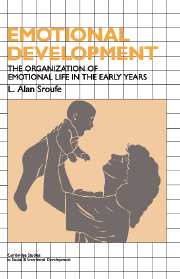Book contents
- Frontmatter
- Contents
- Preface
- Part I The nature of emotional development
- Part II The unfolding of the emotions
- 4 An organizational perspective on the emergence of emotions
- 5 The development of joy: a prototype for the study of emotion
- 6 The development of fear: further illustration of the organizational viewpoint
- 7 The interdependence of affect and cognition
- 8 Meaning, evaluation, and emotion
- Part III Emotional development and individual adaptation
- References
- Index
4 - An organizational perspective on the emergence of emotions
Published online by Cambridge University Press: 16 September 2009
- Frontmatter
- Contents
- Preface
- Part I The nature of emotional development
- Part II The unfolding of the emotions
- 4 An organizational perspective on the emergence of emotions
- 5 The development of joy: a prototype for the study of emotion
- 6 The development of fear: further illustration of the organizational viewpoint
- 7 The interdependence of affect and cognition
- 8 Meaning, evaluation, and emotion
- Part III Emotional development and individual adaptation
- References
- Index
Summary
Just because development is patterned, organized and universal does not mean that there is a map, plan, or scheme for the creation of those patterns … Systematic developmental change processes can emerge out of the mutual constraints imposed on components of the individual-environment system.
Fogel (1993)From an organizational perspective, it is assumed that there is a logic in the appearance of the specific affects and an orderly unfolding of emotions – from neonatal precursors and early infant forms to the more complex emotions of early childhood. This is not to deny the role of genes in the emergence of discrete affective expressions, but to argue that genes are embedded in a developmental process that is characterized by co-action and interaction of all constituent parts (Fogel & Thelen, 1987; Gottlieb, 1991; Oyama, 1985; Thelen, 1989).
The development of emotions such as fear and joy should be characterized by the same principles as all development, and given the unity in development, the same processes are expected to underlie their emergence from precursors or prototypes. Later forms should be more differentiated, more psychologically based (meaning vs. general excitation), and more complexly organized with respect to context; yet later forms should be seen to evolve from earlier forms.
- Type
- Chapter
- Information
- Emotional DevelopmentThe Organization of Emotional Life in the Early Years, pp. 55 - 76Publisher: Cambridge University PressPrint publication year: 1996



